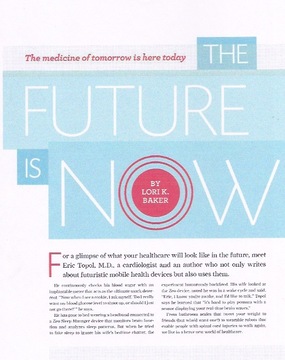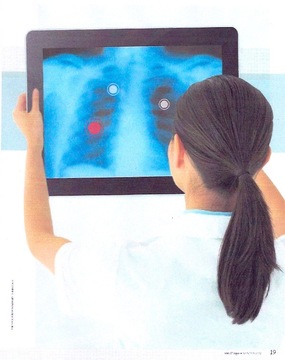The Future Is Now
For a glimpse of what your healthcare will look like in the future, meet Eric Topol, M.D., a cardiologist and author who not only writes about the coolest futuristic mobile health devices, but actually uses them in everyday life. He continuously checks his blood sugar with an implantable meter that acts as the ultimate snack deterrent. “Now when I see a cookie, I ask myself, ‘Do I really want my blood glucose level to shoot up—or should I just not go there?’” he says.
He’s also gone to bed wearing a headband connected to a “Zeo clock” that monitors brain function and helps analyze sleep patterns. But when he tried to fake sleep to ignore his wife’s bedtime chatter, the experiment humorously backfired. His wife looked at the Zeo clock, noted he was in a wake cycle and said, “Eric, I know you’re awake, and I’d like to talk.” Topol says he learned the hard way that “it’s hard to play possum with a sensor displaying your real time brain waves.”
From bathroom scales that can tweet your weight to friends (but who’d want one?) to wearable-robots that can enable people with spinal cord injuries to walk again, we live in a brave new world of health. To learn more about the latest and greatest mobile health devices, we checked in with Topol, author of “The Creative Destruction of Medicine: How the Digital Revolution Will Create Better Health Care,” and Daniel Kraft, who chairs the Medicine track for Silicon Valley-based Singularity University and is executive director of FutureMed, a program that explores convergent technologies that could revolutionize healthcare.
Telemedicine: The Doctor Will Skype You Now
Now: “Since at least 50 percent of office visits may not be necessary, video visits could prove to be important for increasing the efficiency and productivity of both patients and doctors,” Topol says. Technology now makes it possible for patients to see their doctor without asking for time off work, thanks to Cisco’s HealthPresence, a videoconferencing tool with high-tech wizardry such as a telephonic stethoscope and tracking of blood pressure, respiratory rate and heart rhythm. Other tools such as Skype allow computer-to-computer videoconferencing, while Apple’s recent introduction of Facetime on the iPhone is another way to make such video connections possible (provided both you and your doc have an iPhone 4.0 or later iteration).
Next: “I think telemedicine has a lot of interesting potential for better outcomes, lower costs and better access to care, particularly in rural areas, where people have a lot more difficulties in coming in to see their providers,” Kraft says.
Robotics: The Robot Is In
Now: The DaVinci surgical robot isn’t R2D2 wielding a scalpel, but it is a



revolutionary high-tech tool that has been used in more than 200,000 operations a year around the world. During an operation, the surgeon sits at a console and peers into binocular-like lenses at highly magnified views provided by a small camera attached to the end of one of the robotic arms that’s inserted into the patient.
Meanwhile, the other mechanical arm holds tiny surgical tools that make the snips, staunch the blood flow and sew up inside when all is done. The system is frequently used for open-heart surgery, prostate resection, gynecological operations and other procedures to avoid large incisions. Even though “the hardware alone costs $1.5 to $2 million,” Topol says, “the uptake rate by surgeons has been extraordinary.”
Next: Be on the lookout for wearable robotics, or mechanical exoskeletons, made by manufacturers such as Ekso Bionics, to enable people with spinal cord injuries to be able to walk again. “We’re going to change the definition of ‘disability’ to be in some cases superabilities,” Kraft says.
Artificial Intelligence: Doctors’ Smartest Assistants
Now: Fans of the TV question-answering game Jeopardy! watched in amazement as I.B.M.’s computer named Watson outwitted its best human players last year. The trick up Watson’s sleeve is its ability to read and understand 200 million digital pages and deliver an answer within three seconds. Beyond its television premiere and victory, where is Watson going to be first deployed? As a cybernetic assistant service to doctors—not to make diagnoses or give physicians a single answer, but to make suggestions and recommendations and determine probabilities. While there are well-defined treatment guidelines for individual conditions like heart disease, diabetes, asthma and emphysema, these guidelines are far less helpful for patients with more than one condition. For example, some beta-blocker drugs are good for heart disease, but bad for asthma. “Watson can really help us learn about these multiply-challenged patients,” Martin Kohn, chief medical scientist at I.B.M. research, told The New York Times.
Next: “Artificial intelligence and supercomputing are going to be increasingly important over time,” Topol predicts. “Tomorrow you’ll have a voice on your phone say, ‘You’re not getting adequate control of your blood pressure, you should be increasing your dose of blood pressure medication.’”
Nanosensors: Tiny Health Detectors
Now: Anyone with a driver’s license in their wallet knows about the breathalyzer test that can prove you tippled too many martinis at happy hour. But what about a breathalyzer test that can warn you that you have cancer? It may sound far-fetched, but the technology exists today at the Technicon Israel Institute in Haifa, Israel, where sensors using gold nanoparticles have been used to detect distinct breath chemical signatures for various cancers, including lung, breast and prostate cancer. “While quite provocative, this clearly needs considerably more validation,” Topol writes in his book, which also describes another breakthrough technology called the iPill, developed by Phillips Electronics, a company active in wireless sensor and system development. It “can be wirelessly activated to release a drug at a particular site in the gastrointestinal tract,” Topol writes. “We’ll soon see whether wireless technologies can improve [drug] compliance and outcomes for patients.”
Next: Kraft predicts we’ll soon be living with embedded sensors throughout many aspects of our lives. “One of the things that’s going to happen in the future is the concept of sensors everywhere,” he says. “Your fridge will know how many times you opened it at three in the morning. Your bathroom scale will be able to Tweet your weight or put it on Facebook. Social pressure can be powerful, right? So if you declare that you’re going to lose weight, your technology can be a bit of a monitor, and it can give you an edge to staying on your diet. Or it can be something simple like having your kids brush their teeth. If you could put a little sensor on their toothbrush, you could tell if they really brushed for two minutes or for only 20 seconds.”
Smartphones: Health Is Calling
Now: Smartphones are transforming nearly everything we do—from how we communicate with family and friends to how we shop. But now they are merging with other technologies that might make it possible for them to actually save our lives. One example is a technology known as AliveCor, which captures a patient’s real-time heart rhythm directly via a smart phone. The gadget makes it possible to perform a do-it-yourself ECG by placing one finger from each hand on each of its two sensors that record your heart rhythm. “Using this device, an individual with palpitations, lightheadedness, or faintness can use his or her phone to acquire heart rhythm data and send it directly to a physician for interpretation,” Topol writes. But that’s not all. Other smart phone devices such as blood glucose monitors can keep track of your blood sugar levels while others keep tabs on your blood pressure. “It’s very hard to get people to take their blood pressure,” Topol says. “As a cardiologist, I’ve been working on it for 25 years.” But with an app and a blood pressure cuff that connects to your smart phone, “it makes you want to take your blood pressure a lot more often because it’s so much fun,” Topol adds. “This is exciting because we have 70 million Americans with high blood pressure in this country, half of them who do not have it under adequate control. The potential impact here is quite profound.”
Next: No doubt you’ve been in the car when the ominous “Check Engine” light flashed on the dashboard. Kraft predicts a day will come when a similar warning light about your health flashes on your smart phone that you’ve used to track everything from your diet and exercise to your blood pressure and blood glucose levels. “A lot of diseases are detected late,” Kraft says. “What if your vital signs detect early that you’re running into heart trouble?”
There’s an App for That
Need a little help to stay motivated on the way to achieving your health and fitness goals? There’s not only an app for that, there are actually more than 20,000 smart phone apps relating to health and medicine to choose from, says Daniel Kraft, executive director of the FutureMed program at Singularity University in Silicon Valley. “Right now some of the very popular apps help you track and optimize your wellness,” he says. Here are four examples of some of the hottest new apps and consumer medical monitors:
- RunKeeper (runkeeper.com). On a smartphone with GPS and an accelerometer, this app can graphically display data showing the length of time you’ve run, distance, velocity and even the route taken.
- Fitbit (fitbit.com). This wireless accelerometer records each step you take to encourage you to take the recommended 10,000 steps per day.
- Bodybugg and BodyMedia (bodybugg.com and bodymedia.com). These devices can connect to your smart phone to provide data on how many calories you’ve burned throughout the day.